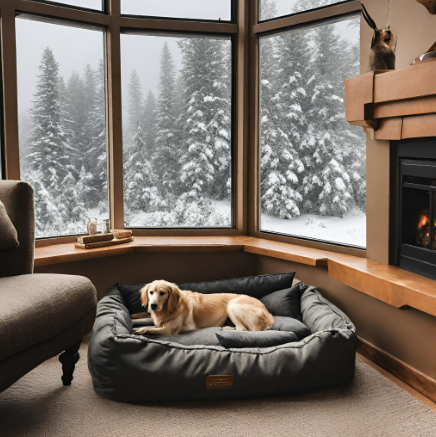Your Ultimate Guide to Understanding and Eliminating Winter Fleas
Introduction: Understanding Fleas in Winter
Fleas in House in Winter? Fleas are more resilient than most people think, especially during the colder months. Contrary to popular belief, these pests don’t simply disappear when the temperature drops. In fact, fleas can thrive in your warm home even in the heart of winter. This adaptability poses a unique challenge for homeowners. …Click Here to read more interesting Flea Articles!

Fleas adapt to cold weather by seeking warmth and shelter. This makes our homes, with their cozy nooks and central heating, perfect havens for these pests. As a result, a flea infestation in winter is not just possible, but also quite common. It’s crucial to be vigilant and proactive in these colder months.
Moreover, addressing flea problems in winter is vital for the health and comfort of both pets and humans. Fleas can transmit diseases and cause allergic reactions. According to the Centers for Disease Control and Prevention (CDC), fleas are known carriers of various bacteria and viruses. They can spread diseases like plague and typhus, highlighting the importance of timely action against these tiny but dangerous pests.
In this guide, we’ll explore the behavior of fleas in winter, debunk myths, and provide actionable advice for keeping your home flea-free. Stay informed and prepared to protect your household from these unwelcome winter guests.
Identifying a Flea Infestation in Winter
Detecting fleas in your home during winter is crucial for timely and effective control. Knowing what to look for can save you from a full-blown infestation.
Signs of Fleas in Your Home
The first step in identifying a flea problem is recognizing the signs. On your pets, watch for excessive scratching, biting, or hair loss, which are classic indicators of flea activity. In the home, keep an eye out for flea dirt – these small, dark specks are flea feces and a telltale sign of their presence. You might also spot tiny, jumping insects or flea larvae in carpets, bedding, or upholstered furniture.
Flea Identification Techniques
Differentiating fleas from other pests is key to effective control. Fleas are small (about 1/8 inch long), dark, and wingless. They are known for their remarkable jumping ability. To confirm their presence, use a flea comb on your pet over a white sheet or paper towel. This will help you spot fleas or flea dirt easily. Also, consider using a magnifying glass to examine any tiny insects you find in your home. If in doubt, consulting with a veterinarian or pest control expert can provide definitive identification.
Recognizing these signs early is vital for controlling fleas efficiently. Stay observant and act promptly to keep these winter pests at bay. Fleas in House in Winter
Preventive Measures to Keep Fleas at Bay
Preventing fleas from infesting your home, particularly in winter, is far easier and more effective than trying to eliminate them once they’re established. Implementing proactive strategies is key to keeping your home flea-free during these colder months.
Winter-Proofing Your Home Against Fleas
Sealing off potential entry points is a critical first step. This includes fixing gaps in doors, windows, and walls. Regular cleaning and vacuuming are also essential. Fleas thrive in undisturbed areas, so frequent cleaning disrupts their lifecycle. Pay special attention to pet bedding, carpets, and upholstered furniture. Washing bedding in hot water and using a powerful vacuum can significantly reduce the risk of flea infestation. Fleas in House in Winter
Protecting Your Pets

Your pets are the primary targets for fleas. Regularly treating them with vet-recommended flea control products is crucial. This could be topical treatments, oral medications, or flea collars. Also, maintain a regular grooming schedule. Frequent baths and combing with a flea comb can help catch fleas before they become a bigger problem. Remember, a pet well-protected against fleas is your first line of defense in keeping your home flea-free.
Adopting these preventive measures creates a hostile environment for fleas, significantly reducing the likelihood of an infestation. Prevention is always better than cure, especially when it comes to fleas in your home during winter.
Effective Home Remedies and Solutions
When it comes to controlling fleas in your home during winter, there are several effective home remedies and over-the-counter solutions that can offer significant relief. Choosing the right method depends on the severity of the infestation and your personal preferences regarding chemical use.
Natural and Chemical-Free Approaches
For those preferring a natural approach, homemade flea traps and natural repellents can be surprisingly effective. A simple flea trap can be made using dish soap and water in a shallow dish, placed near light sources overnight to attract and trap fleas. Essential oils like lavender, eucalyptus, and peppermint, known for their flea-repelling properties, can be used safely around the home. However, it’s crucial to ensure these oils are diluted and used in a pet-safe manner.
Over-the-Counter Products and Their Efficacy
For more severe infestations, over-the-counter products can offer a more robust solution. Flea sprays, powders, and foggers containing insecticides can effectively reduce flea populations. It’s important to follow the instructions carefully and consider the safety of all household members, including pets. Some of these products provide immediate relief, killing adult fleas on contact, while others offer longer-term protection by interrupting the flea life cycle.
Whether you choose a natural remedy or an over-the-counter solution, the key is consistency and thorough application. Regularly treating your home and pets, along with maintaining good cleanliness practices, can significantly reduce the risk of flea infestations during the winter months.
Professional Extermination: When and Why to Consider It
There are instances when a flea infestation in your home during winter is too severe for DIY methods. In such cases, professional extermination becomes a necessary and effective solution. Understanding when to call in the experts and how to choose the right service is crucial.
Assessing the Severity of Infestation
If you’ve tried various home remedies and over-the-counter products without success, it may be time to consider professional help. Signs of a severe infestation include persistent flea presence despite treatment, widespread infestation throughout the home, and repeated flea bites on household members. Professional exterminators have the tools, knowledge, and experience to deal with extensive infestations more effectively than typical home treatments. Fleas in House in Winter
Selecting a Reputable Flea Extermination Service
Choosing the right extermination service is vital. Look for licensed, experienced professionals with good reviews. Ask about their treatment methods and ensure they use safe, effective techniques. Before the exterminator’s visit, prepare your home by cleaning thoroughly and following any specific instructions they provide. This will help maximize the effectiveness of their treatment.
Professional extermination can offer a comprehensive solution to a flea problem that home remedies can’t tackle. It’s a crucial step in ensuring your home remains comfortable and flea-free throughout the winter. Remember, the sooner you address a severe infestation, the easier it will be to reclaim your home from these pesky intruders.
Conclusion: Maintaining a Flea-Free Home
Successfully tackling a flea infestation during the winter is just the beginning. To ensure your home remains flea-free, adopting long-term strategies for flea control is essential. Let’s wrap up with some key takeaways and final tips to maintain a comfortable, flea-free environment year-round. Fleas in House in Winter
Long-Term Strategies for Flea Control
Regular maintenance is crucial in preventing future infestations. Establish a routine for cleaning and inspecting your home, especially in areas where pets frequent. Consistently wash pet bedding, vacuum carpets, and use flea prevention products on your pets. Remember, ongoing vigilance is key to keeping fleas at bay.
Summary of Key Takeaways and Final Tips
In conclusion, dealing with fleas in winter requires a comprehensive approach: from identifying early signs to implementing effective prevention strategies. Whether using home remedies, over-the-counter products, or professional services, consistency and thoroughness are vital. And don’t forget, keeping your pets protected against fleas plays a significant role in maintaining a flea-free home.
By following these guidelines, you can enjoy the colder months without the worry of unwelcome flea guests. Remember, the efforts you put into flea prevention and control today can save you from the hassles of a major infestation tomorrow. Stay proactive and keep your home a comfortable, flea-free zone all year round.